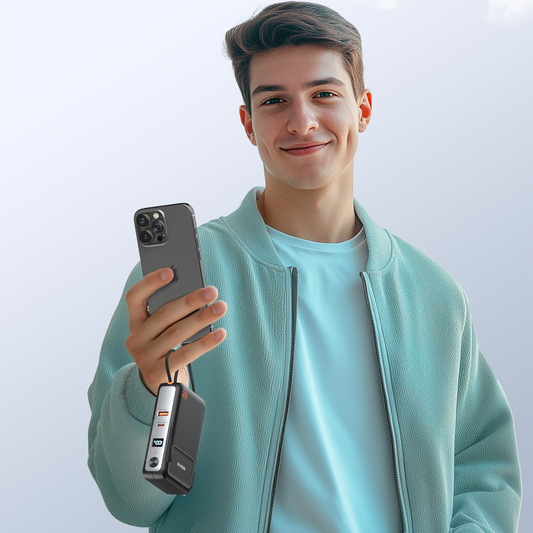Mastering the Charge: A Comprehensive Guide to Charging Your Power Bank
Contents
Introduction
In our tech-driven world, the importance of keeping our devices powered up is vital. From our smartphones to laptops, these devices are crucial for our communication, daily work, and entertainment enjoying. So that a reliable and safe power source is not merely a matter of convenience but a necessity for navigating daily life efficiently. The seamless functioning of our devices is integral to productivity and staying connected, aiming the importance of addressing power challenges. As we explore this topic, on the basis of innovative solutions and emerging trends, it is necessary that we should promote resilience and level up our productivity in our fast-paced, digitally reliant lifestyles with fully power charged.
Nowadays, a power bank serves as a portable external battery, perfectly designed to recharge electronic devices on the go. In our gadget-dependent lives, power banks have become more and more prominent during our daily use. With the increasing power demands of smartphones, tablets, laptops and other devices, power banks provide a indispensable solution to the constant need for charging. They offer a convenient and portable source of energy, ensuring that users remain connected and productive in whole day, regardless of access to traditional power outlets. As a compact and versatile accessory, the power bank has become an essential tool, offering users with the reassurance of uninterrupted device functionality in diverse needs.
Section 1: The Basics of Power Banks
Power banks are compact, portable devices equipped with rechargeable batteries, typically lithium-ion or lithium-polymer, designed to store electrical energy. They are also equipped with input and output ports, allowing users to charge their electronic devices on their way. When plugged in, the power bank's batteries store energy; when needed, this stored energy is then transferred to the connected device through its output port. Some of advanced power bank features fast-charging technologies and multiple ports. This technology enables users to extend the battery life of smartphones, tablets, and other gadgets, providing a convenient and mobile charging solution.
Power banks come in different types to meet diverse needs. Standard power banks offer basic charging, while solar power banks absorb sunlight and then transfer solar energy into electricity for eco-friendly use. Wireless power banks support cable-free charging, and quick charge variants provide faster charging for compatible devices with time-saving enjoyment. High-capacity power banks offer extended power, great for energy-intensive gadgets. Ultra-compact models prioritize portability, fitting into small spaces. Multi-function power banks integrate features like flashlights or speakers which can help you solve different problems while in daily life. Laptop power banks cater to higher voltage requirements, while rugged designs withstand tough conditions. Modular power banks allow customization depending on preferences, charging needs, and device compatibility, considering factors like capacity, size, and features.
Section 2: Understanding Your Power Bank's Requirements
Power bank packaging typically includes specifications crucial for buyers. Capacity (measured in mAh) indicates how much charge the power bank can store; rated capacity on a power bank usually expressed in milliampere-hours (mAh) or watt-hours (Wh) and it represents the total amount of energy the power bank is designed to store and deliver to connected devices. Output voltage and current (measured in volts and amps) reveal the charging speed, with higher values providing faster charging. Input voltage and current indicate how quickly the power bank itself recharges. Number of USB ports signifies simultaneous charging capability. The total output is the maximum power that can be distributed across all those ports simultaneously. The "built-in cell type" of a power bank refers to the specific type of rechargeable battery technology incorporated within the device. The two most common types of built-in cells in power banks are lithium-ion (Li-ion) and lithium-polymer (Li-Po) batteries. All the above mentioned are vital to match these specifications with device requirements for optimal charging efficiency and compatibility.
There is no doubt that knowing your power bank's input voltage and current is crucial to ensure efficient and timely recharging. Matching these specifications with the charger's output requirements prevents damage, optimizes charging speed, and extends the power bank's lifespan. Incorrect input values may result in slow charging, overheating, or potential long-term damage.
Section 3: Preparing to Charge Your Power Bank
Before charging your power bank for the first time, please read the manual thoroughly for specific instructions. Check the power bank for damage and ensure it meets your device's charging needs. Use a compatible charger or charging cable with the correct voltage and current. Charge the power bank in a well-ventilated, cool environment, away from direct heat. Fully charge it before its first use, following your user guide. Monitor the temperature during charging, and avoid overcharging by disconnecting when the power bank reaches full capacity. Place it on a stable surface for safety.
Without worrying about the damages to power bank with overnight charging because most of modern power banks have built-in protection mechanisms to prevent overcharging. Lithium-ion batteries, common in power banks, don't have the memory effect. Charging partially is fine. You don't have to worry about that charging too fast damages devices for quality power banks regulate charging speed to prevent damage. Fast charging is safe when supported by devices. Unplugging when full extends battery life for better chip and technology supported.
Section 4: Charging Your Power Bank Efficiently
You can follow following steps for recharging your power bank:
Step1: Connect the power bank to a compatible standard charger with standard cable;
Step2: Plug the charger into a power source;
Step3: Wait until the power bank is being fully charged;
Step4: Unplug after being fully charged and store in a dry and cool place until for using.
To maintain power bank battery health during charging, you should use a compatible and standard charger and cable, avoid overcharging, charge in a dry, clean and tidy environment, and store at moderate temperatures. Regularly charge and discharge the power bank to optimize battery performance, and follow the user guide for optimal usage.
Section 5: Choosing the Right Charger
How to select the best charger for your power bank.
Matching its output voltage and current with your power bank's input requirements. Choose a reputable brand, avoid counterfeit chargers and cables, and follow user manual for compatibility. All the above mentioned are best methods for better power bank chargers selected.
The role of wall chargers, USB ports, and car chargers in the charging process.
Wall chargers offer fast, stable charging at home, office and other indoor places. USB ports offer versatile charging from computer, laptops and adapters. Car chargers facilitate on-the-go charging in vehicles. Each serves a unique purpose, fits for various scenarios and ensuring power banks can be charged conveniently in different environments.
Section 6: Charging Safety Tips
Safety precautions to take while charging your power bank.
① Use the provided standard charger and cable.
② Charge in a well-ventilated area.
③ Avoid overcharging to prevent overheating.
④ Monitor the charging process in time.
⑤ Keep the power bank away from flammable materials.
⑥ Disconnect when fully charged.
⑦ Store in a dry, clean and tidy environment.
Understanding the risks of overcharging and how to avoid them.
Overcharging a power bank can lead to overheating, shorten battery life, or even safety hazards. To avoid risks, use the charger and cable with the correct specifications, unplug when fully charged, and store the power bank in a clean and tidy place. Following manufacturer guidelines prevents overcharging and ensures safe usage.
Section 7: Troubleshooting Common Charging Issues
What to do if your power bank won't charge.
If your power bank won't charge, try using a different charging cable or adapter. Ensure the power source is functioning. Check for any visible damage on the power bank or check the input port and output port of power bank. If issues persist, contact the manufacturer's customer support for professional guidance, and refrain from attempting to repair it yourself to avoid potential risks.
How to determine if your power bank is charging as it should.
To ensure your power bank is charging correctly, monitor the charging indicators, if available. Confirm the device is connected properly and the charging cable is undamaged. Check for signs of overheating. If uncertain, consult the user manual for specific instructions or contact the manufacturer's customer for professional support.
Section 8: Maximizing Power Bank Performance
Best practices for charging your power bank to extend its life and the ideal charging cycle for optimal performance.
To extend your power bank's lifespan, use a compatible and standard charger and cable, avoid overcharging, and store it in a cool place. Aim for a regular charging cycle—recharge when the battery is around 20-30% and stop once being fully charged. Lithium-ion batteries, commonly used in power banks, benefit from avoiding extreme charge levels. Follow manufacturer guidelines and occasionally allow the power bank to discharge partially before recharging for long-term health.
Conclusion
Correctly charging your power bank is vital for longevity and safety. Use standard chargers and cables, avoid overcharging, and follow user guide. Proper charging practices ensure optimal performance, preventing potential risks and damage.
Let's us listen to your own power bank charging tips. We'd love to hear from you! Write down your insights in the comments below. Let's build a community of knowledge and help each other make the most out of our power bank charging routines. We are waiting for you.
Explore MOKiN's diverse range of power banks and charging solutions for reliable, efficient, and convenient charging experiences. Visit our website today to find the perfect companion for your devices!
Links Mentioned in the Article
-
24000mAh 140W Power Bank for Laptop - Explore the high-capacity, fast-charging power bank designed by MOKiN for laptops.
-
18400mAh 65W Power Bank for Laptop - Learn about MOKiN's fast-charging power bank that offers stable and efficient power supply for laptops.
-
USB C Charger & Power Bank Blog for MOKiN - Read the latest news and insights about MOKiN USB C chargers and power banks.
- MOKiN Power Banks - MOKiN: Ultimate Power Banks for Devices | Fast Charge

MOKiN 13-IN-1 USB-C Laptop Charging Station with 2.26-inch LCD Smart Display








